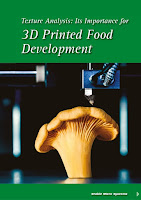The food industry is experiencing a paradigm shift. People’s growing awareness of the food that they consume and the drive for new customized sensory experiences is pushing for the development of new technologies that can satisfy these new consumers’ standards. One of these novel technologies, 3D Printing, has been around for a while, however, only in 2007 was it applied for the first time in the production of food structures.
This technology has attracted a lot of attention for its versatility and potential application in various production sectors, such as aerospace, electronics, architecture, and medicine but it is becoming more apparent that in the food production sector this technology has the potential to be used to create personalised food products, enabling the creation of food products with specific design characteristics, flavours and colours, geometric structures, textures, and nutritional profiles.
Some corporations are already using this technology in the fabrication of their products, such as Hershey’s (chocolates), Barilla (pasta noodle), Ruffles (potato chips), Oreo (cookies), and Mazola (fruits and vegetables). In the production of meat-based products, Aleph Farms and Meatech use 3D Printing in the production of laboratory-grown meat, and Redefine Meat and Novameat for plant-based meat.
Beyond taste and appearance, one of the major factors in consumer acceptability is the texture and mouthfeel of the food. While taste and appearance are the factors that attract more attention during food production and consumer purchase, texture is crucial in food preferences and can make a difference at the time of purchase
In the case of elderly and people with swallowing problems (dysphagia), their need to consume texture-modified foods, that—for safety reasons—must be pureed, can constitute a problem because of its unappealing look and texture that can lead to food rejection and malnourishment. Much in the same way, texture can have a big impact on people with food aversions.
Food Texture Design by 3D printing: A Review is a recently published excellent introduction document into the background of 3D printed food and specifically how it could be applied to produce tailored foods for specific needs such as foods for the elderly. Advantages and limitations of 3D Printing in the food industry, the material-based printability and model-based texture, and the future trends in 3D Printing, including numerical simulations, incorporation of cooking technology to the printing, and 4D modifications are discussed. Key challenges for the mainstream adoption of 3D Printing are also elaborated on.
To read more about how to apply texture analysis to your 3D printed food developments, you might like to request this article:
Texture Analysis: Its importance for 3D Printed Food DevelopmentThere is a Texture Analysis test for virtually any physical property. Contact Stable Micro Systems today to learn more about our full range of solutions.
For more information on how to measure texture, please visit the Texture Analysis Properties section on our website. The TA.XTplus texture analyser is part of a family of texture analysis instruments and equipment from Stable Micro Systems. An extensive portfolio of specialist attachments is available to measure and analyse the textural properties of a huge range of food products. Our technical experts can also custom design instrument fixtures according to individual specifications.
The TA.XTplus texture analyser is part of a family of texture analysis instruments and equipment from Stable Micro Systems. An extensive portfolio of specialist attachments is available to measure and analyse the textural properties of a huge range of food products. Our technical experts can also custom design instrument fixtures according to individual specifications.
No-one understands texture analysis like we do!
To discuss your specific test requirements click here...
 |  |  |



No comments:
Post a Comment